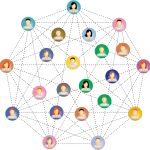3.4 Connectivism

While behaviorists and cognitivists focused on the individual learning and social learning theories looked at learning within social systems, George Siemans (2005) believed that learning and knowledge could exist outside the person in a complex web of people and information sources. According to Sieman’s (2005) Connectivist Theory, the following principles apply to learning:
- Learning and knowledge rest in diversity of opinions.
- Learning is a process of connecting specialized nodes or information sources.
- Learning may reside in non-human appliances.
- Capacity to know more is more critical than what is currently known.
- Nurturing and maintaining connections is needed to facilitate continual learning.
- Ability to see connections between fields, ideas, and concepts is a core skill.
- Currency (accurate, up-to-date knowledge) is the intent of all connectivist learning activities.
Decision-making is itself a learning process. Choosing what to learn and the meaning of incoming information is seen through the lens of a shifting reality. While there is a right answer now, it may be wrong tomorrow due to alterations in the information climate affecting the decision” (Siemans, 2005, online).
For more complete information on Connectivism, see the original article by Seimans.
This resource is no cost at https://open.library.okstate.edu/foundationsofeducationaltechnology

